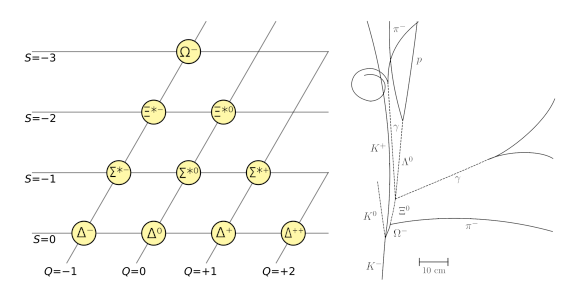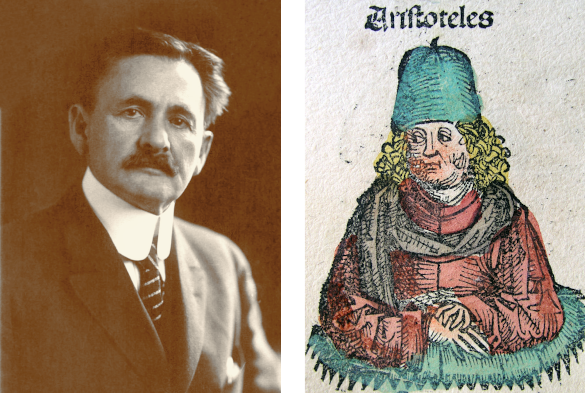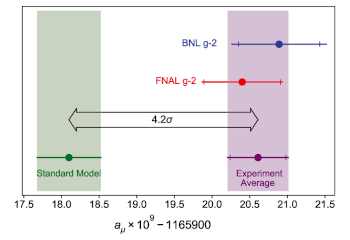Non-Standard Muon
May 24, 2021
Readers of this
blog are likely familiar with the
spherical cow parable about a
physicist who was assigned the task of finding ways to increase
milk production on a
dairy farm. After completing his study, he began the presentation of his
research results with the
phrase, "Consider a spherical cow." I just read another physics-themed
cow joke that describes a cow's favorite
elementary particle as the
muon. Unfortunately, the joke is based on the
mispronunciation of the
Greek letter,
mu (μ). It would have been funnier if it was a
cat's favorite elementary particle.
Physicists love the
Greek alphabet at least as much as
mathematicians. The muon is just one of the many Greek letter named
subatomic particles, the most famous example of which is the
Omega-minus (Ω-) particle that was discovered at
Brookhaven National Laboratory in 1964 (see figure). This discovery confirmed a 1961
theory of the
quark model by
American physicist
Murray Gell-Mann (1929-2019) and
Israeli physicist
Yuval Ne'eman (1925-2006).

On the left, a baryon decuplet of Delta (Δ), Sigma (Σ), Xi (Ξ), and Omega (Ω) baryons. In this illustration, Q is electric charge and S is strangeness. On the right is a tracing of the bubble chamber photograph of the discovery of the Omega minus particle. (Left, a modified Wikimedia Commons image. Right, a Wikimedia Commons image. Click for larger image.)
The muon has been in the news recently as the result of an
experiment on its
magnetic moment that shows a 4.2
standard deviation difference from the
Standard Model.[1-11] The Standard Model is the
theory that adequately describes three of the four known
fundamental forces and classifies all known elementary particles. Since 4.2 sigma is still short of the accepted
gold standard of 5 sigma in
particle physics experiments, this finding is said to be
compelling evidence of new physics and not an actual discovery.[3] The research team for this experiment was composed of more than 200
scientists from 35 institutions in seven countries.[3]
American physicist,
Albert Michelson (1852-1931), who conceived the
Michelson–Morley experiment that demonstrated the absence of a
luminiferous aether, famously said that "
the future truths of physical science are to be looked for in the sixth place of decimals." The accepted theoretical value for the muon g-factor is 2.00233183620(86), while the experiment gives 2.00233184122(82).[3] This means that the discrepancy lies at the eighth decimal place.

Albert Michelson (1852-1931) (left) and Aristotle (384-322 BC). In his Physics, Aristotle wrote about an aether that surrounds the celestial bodies. In this illustration from the 1493 Nuremberg Chronicle, Aristotle is clothed in the manner of a medieval scholar. This would be a good meme for a thinking cap, the supposed headwear designed to improve thinking. (Left, a Wikimedia Commons image by AstroLab, modified for artistic effect. Right, a Wikimedia Commons image from the Nuremberg Chronicle.)
The muon has the same
charge and
spin as an
electron, and it's also an elementary particle with no known sub-structure; that is, it's not a
composite of other, simpler particles. The muon is the electron's
fat cousin, and not by just a little. A muon has a
mass that's 206.768 times as large. A muon can replace an electron in an
atom; so, a
hydrogen atom can be constructed from a muon and a
proton. Since a muon is more massive than an electron, its
atomic orbitals are closer to the
nucleus, and this enables some experimental tests of
quantum electrodynamics that I wrote about in a
previous article (The Proton Size Problem, November 3, 2016).
The Standard Model has endured all tests since its conception in the
1970s, but physicists are still looking for cracks in its edifice, and that's the purpose of the Muon g−2 Experiment at the
Fermi National Accelerator Laboratory (Fermilab). This experiment is named after the
magnetic g-factor that it probes.[1] This same type of experiment was conducted at
Brookhaven National Laboratory twenty years ago, and it showed a 2.7-sigma discrepancy between the experimental and theoretical value.[2-3]. In fact, the
superconducting magnet of the Brookhaven measurement was shipped to Fermilab for its experiment.[3] This new
statistic of a 4.2-sigma discrepancy combines the Brookhaven and Fermilab
data.[1]

Experimental values of The muon anomaly aμ from the Brookhaven National Laboratory experiment, the Fermilab experiment, and their combined average. The value for the Standard Model is also shown.
(Fig. 4 of Ref. 1, licensed under a Creative Commons Attribution 4.0 International license. Click for larger image.)
This magnet is a 50-foot-diameter superconducting magnetic
storage ring that creates a
uniform vertical magnetic field in which the muons circulate.[2-3] The magnet was
tweaked using 8000 hand-cut strips of
iron foil glued onto it to give a threefold improvement in uniformity above what was achieved at Brookhaven.[2,8] The magnet is sensitive to
environmental conditions, such as
temperature, so it is monitored by an array of 378
nuclear magnetic resonance probes based on proton
spin precession in
water.[1,8]
The measurement is based on the idea that the g -factor, which is exactly 2 for an ideal point particle with spin 1/2, has a slightly different g-factor as it interacts with the
quantum foam of
virtual particles. The deviation from 2 is what's important, and that's why the experiment is called Muon g−2.[2-3] The Standard Model predicts this effect with extreme
precision, and that's why measuring the g-factor is a good test.[3]
The Fermilab results vindicate the Brookhaven data. The
published results are based on a experimental run done in 2018, but further data taken in 2019 and 2020 are now being
analyzed, two additional runs are planned, and there's a
potential of achieving 7-sigma significance in the statistics.[2,3] Other groups have different g-factor experiments planned.[2] Says
Chris Polly, a Fermilab
scientist and a
co-spokesperson for the current experiment,
"So far we have analyzed less than 6% of the data that the experiment will eventually collect. Although these first results are telling us that there is an intriguing difference with the Standard Model, we will learn much more in the next couple of years."[3]
Alexey Petrov, a
theorist at
Wayne State University says that development of a model beyond the Standard Model "... is going to be a
field day for theorists.[7] The Muon g-2 experiment was
funded by the
US Department of Energy, the
National Science Foundation, and the
German Research Foundation, among other sources.[1]
References:
- B. Abi et al. (Muon g−2 Collaboration), "Measurement of the Positive Muon Anomalous Magnetic Moment to 0.46 ppm," Physical Review Letters, vol. 126 (April 7, 2021), Article 141801, DOI:https://doi.org/10.1103/PhysRevLett.126.141801. This is an open source article with a PDF file here.
- Priscilla Cushman, "Muon's Escalating Challenge to the Standard Model," Physics, vol. 14, no. 54, April 7, 2021.
- Tracy Marc, "First results from Fermilab’s Muon g-2 experiment strengthen evidence of new physics, Fermilab Press Release, April 7, 2021.
- Fact Sheet: Muon g-2 Experiment (PDF file), Fermilab
- Muon g-2 experiment finds strong evidence for new physics, Fermilab YouTube Video, April 7, 2021.
- Davide Castelvecchi, "Is the standard model broken? Physicists cheer major muon result," Nature, April 7, 2021, doi: https://doi.org/10.1038/d41586-021-00898-z.
- Adrian Cho, "Particle mystery deepens, as physicists confirm that the muon is more magnetic than predicted," Science, April 7, 2021, doi:10.1126/science.abi8829.
- Michael Schirber, "Measuring the Magnet that Measures the Muon," Physics, vol. 14, no. 53 (April 7, 2021).
- Mounting hope for new physics, Johannes Gutenberg-Universität Mainz Press Release, April 7, 2021.
- Savannah Mitchem, "Field guides: Argonne scientists bolster evidence of undiscovered particles or forces in Muon g-2 experiment," Argonne National Laboratory Press Release, April 7, 2021
- Particle physics: will muons lead us towards a new physics?, CNRS Press Release, April 7, 2021.
Linked Keywords: Blog; spherical cow; parable; physicist; milk; dairy farm; research; phrase; cattle; cow; joke; elementary particle; muon; mispronunciation; Greek alphabet; Greek letter; Mu (letter); μ; cat; mathematician; subatomic particle; Omega baryon; Omega-minus (Ω-) particle; Brookhaven National Laboratory; Eightfold Way %28physics%29; quark model; America; American; Murray Gell-Mann (1929-2019); Israel; Israeli; Yuval Ne'eman (1925-2006); baryon decuplet; Delta baryon (Δ); Sigma baryon (Σ); Xi baryon (Ξ); Omega baryon (Ω); baryon; electric charge; strangeness; bubble chamber; photograph; Wikimedia Commons; experiment; magnetic moment; standard deviation; Standard Model; theory; fundamental interaction; fundamental force; gold standard (test); particle physics; scientist; Albert Michelson (1852-1931); Michelson–Morley experiment; luminiferous aether; the future truths of physical science are to be looked for in the sixth place of decimals; Aristotle (384-322 BC); Physics (Aristotle); aether (classical element); astronomical object; celestial body; Nuremberg Chronicle; clothing; clothed; Middle Ages; medieval; scholar; meme; thinking cap; headgear; headwear; thought; thinking; AstroLab; charge (physics); spin (physics); electron; composite particle; obesity; fat; cousin; mass; atom; hydrogen atom; proton; atomic orbital; atomic nucleus; quantum electrodynamics; 1970s; Fermi National Accelerator Laboratory (Fermilab); g-factor (physics); magnetic g-factor; Brookhaven National Laboratory; superconducting magnet; statistics; data; anomaly (physics); mean; average; Creative Commons Attribution 4.0 International license; storage ring; homogeneity; uniform; vertical direction; magnetic field; tweaking; tweaked; iron; foil (metal); adhesive; glue; environment (biophysical); environmental; temperature; nuclear magnetic resonance; Larmor precession; spin precession; water; quantum foam; virtual particle; precision; scientific literature; published; analysis; analyzed; potential; Chris Polly; scientist; co-spokesperson; Alexey Petrov; theorist; Wayne State University; field day; funding of science; funded; United States Department of Energy; National Science Foundation; German Research Foundation.